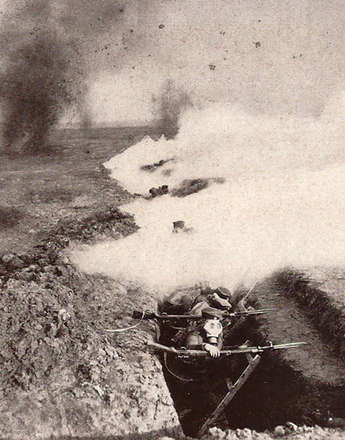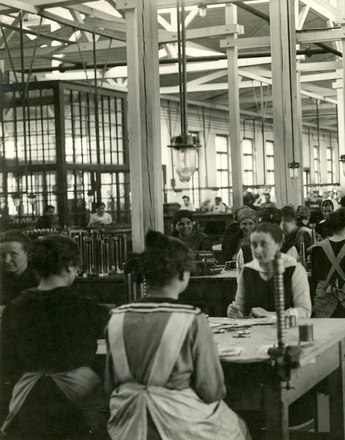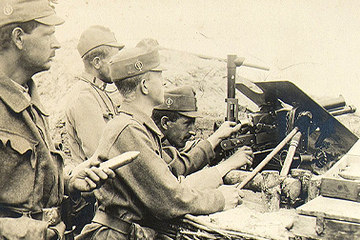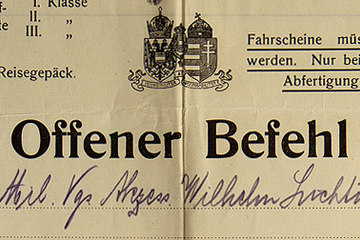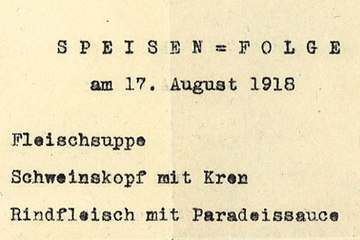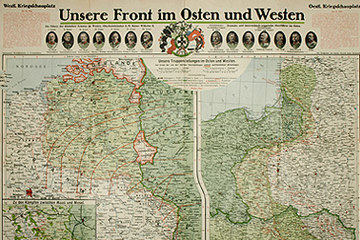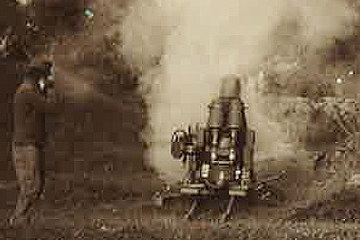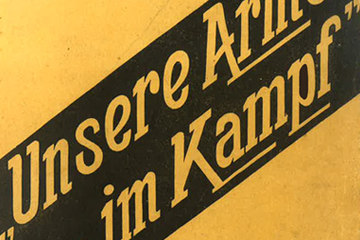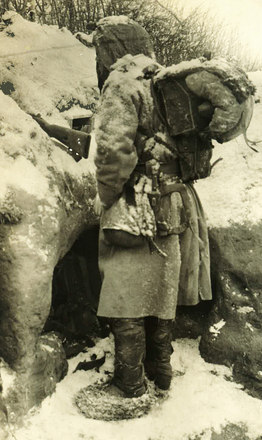
Soldier in the snow, photo
Copyright: Heinrich Posch
-

Soldiers in front of a cavern at the weapon store, October 1916
Copyright: Sammlung Frauennachlässe, Institut für Geschichte der Universität Wien
Partner: Sammlung Frauennachlässe, Institut für Geschichte der Universität Wien -

Theodor Gribovski with field telephone, photo, 1916
Copyright: private Leihgeberin
In summer 1914, probably no one in the Habsburg Monarchy could imagine what effects the coming war would have and what measure of suffering it would cause. And probably only very few thought that the “Gang nach Serbien” (the move to Serbia), as a retaliation campaign, would last more than four years, or that during this time, all in all, around eight or nine million men would be mobilised (the statistics diverge in the literature). They make up that anonymous and nameless collective whose everyday life on the fronts of the Austrian-Hungarian Monarchy has never received sufficient attention. Because until quite recently, with few exceptions, there has been only a laggard attempt to pose questions in Austrian historiography about the everyday experiences, awareness, sense of purpose and interpretations in particular of the normal trooper.
This may surprise and even amaze, because, according to the historian Christa Hämmerle, if we look at wartime society and its military leaders “the soldiers – real and imagined – were given the greatest attention and priority for the whole duration of the war.”
Moreover, the Austrian research landscape on the First World War can also avail of comprehensive international scholarship. The focus of its investigations since the 1980s was directed for example on the ‘booming’ history of first-hand reports made by witnesses taking part in the war, the history of everyday life as contained in diaries, forces post and biographical memoirs. Combined with views based on experiences and the history of women and gender, also cultural history introduced into historical academic research in recent years, such sources direct attention towards questions of individual experience and life, memory, self-awareness and -interpretations, ideas of manliness and womanliness, (collective) identities and more.
One of the things the investigations can deduce from these research premises is that the (!) everyday life on the front or the (!) war experience of the (!) soldier never existed.
Historians have to face the far greater task of tackling the profusion of individual experiences, which are then again linked to time and context and thus not easy to generalise. The respective experiences on the front were indeed shaped by many different circumstances and dependent on them. They were affected for instance by a soldier’s position and rank, the weaponry he was handling, the location of action and its duration, the structure within his own troop, the relationship to his superior officers and so forth. Meanwhile we have to take into account such factors as age, the economic and social situation, family status and most of all, in view of the multi-ethnic Habsburg Empire, the soldiers’ nationality.
Translation: Abigail Prohaska
Bachinger, Bernhard/Dornik, Wolfram: Jenseits des Schützengraben-Narrativs? Einleitende Bemerkungen über Kriegserfahrung und Kriegserinnerung an der Ostfront im Vergleich, in: Dies. (Hrsg.): Jenseits des Schützengrabens. Der Erste Weltkrieg im Osten: Erfahrung – Wahrnehmung – Kontext, Innsbruck/Wien/Bozen 2013, 11–23
Hämmerle, Christa: Geschlechtergeschichte/n des Ersten Weltkriegs in Österreich-Ungarn. Eine Einführung, in: Dies.: Heimat/Front. Geschlechtergeschichte/n des Ersten Weltkriegs in Österreich-Ungarn, Wien/Köln/Weimar 2014, 9–25
Hämmerle, Christa: Soldaten, in: Labanca, Nicola/Überegger, Oswald (Hrsg.): Krieg in den Alpen. Österreich-Ungarn und Italien im Krieg, Wien/Köln/Weimar 2014, im Druck
Rauchensteiner, Manfried: Der Erste Weltkrieg und das Ende der Habsburgermonarchie, Wien/Köln/Weimar 2013
Szlanta, Piotr: Unter dem sinkenden Stern der Habsburger. Die Ostfronterfahrung polnischer k.u.k. Soldaten, in: Bachinger, Bernhard/Dornik, Wolfram (Hrsg.): Jenseits des Schützengrabens. Der Erste Weltkrieg im Osten: Erfahrungen – Wahrnehmungen – Kontext, Innsbruck/Wien/Bozen 2013, 139–156
Quotes:
„the soldiers – real ...“: quoted from: Hämmerle, Christa: Soldaten, in: Labanca, Nikola/Überegger, Oswald (Hrsg.): Krieg in den Alpen. Österreich-Ungarn und Italien im Krieg, Wien/Köln/Weimar 2014, in the press

